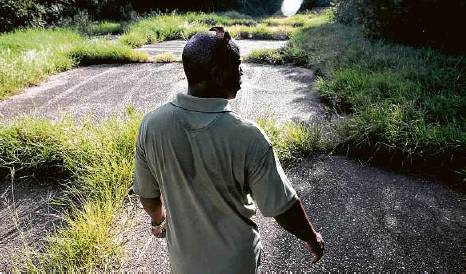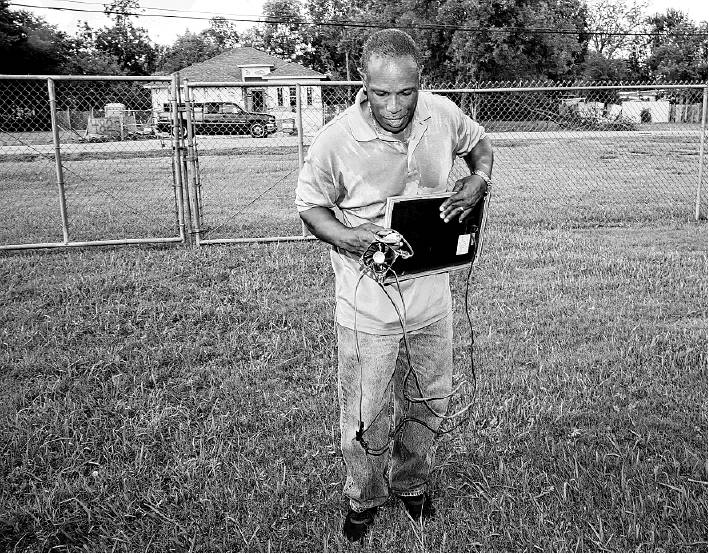Solar farm proposed for Sunnyside
Resident hopeful that former landfill also can serve as an agricultural hub, education center
By Perla Trevizo STAFF WRITER
What was once the site of Houston’s largest incinerator — and a place where people would dump old appliances and dead animals — could soon become the state’s largest urban solar farm and a food source for a community that has long been underserved.
Call it atonement through development.
The massive Sunnyside landfill, which was capped decades ago and covers an area that’s the size of more than 200 football fields, is now covered by hundreds of trees, overgrown shrubs and swarms of mosquitoes.
Now a team of private companies, architects, neighborhood groups and city officials is pursuing a plan to transform the site into thousands of solar panels, and an agricultural hub and education center built out of containers.
The latest push follows failed efforts over the years to turn the land — a short drive from downtown Houston — into, among others things, a golf course and an office complex.
A commercial solar farm would take up the biggest share, about 220 acres, with another 12 acres reserved for community solar power for those who can’t afford it or don’t own ahome that could benefit from solar panels. Another 2 acres would be set aside as space for the community to learn and grow produce not by digging in the contaminated soil, but by using aquaponics —a method of growing plants that uses water while at the same time raising aquatic animals such as fish. The project is estimated to begin in 2021, contingent on the lining up of investors.
Early plans call for the development of a 70-megawatt solar array that would generate enough electricity for about 12,000 homes. Other potential benefits include jobs and training, discounts for lower-income residents in the neighborhood, and reduced flooding. Sunnyside Energy, a newly created LLC, would lease the land from the city and restore and maintain the landfill cover; the city would continue to own the site and retain liability.
The project was selected as part of “Reinventing Cities,” a global-design competition in which major cities identify underutilized land for teams of developers, architects and neighborhood groups to come up with redevelopment proposals focused on resiliency and community.
“A landfill is that sort of rare piece of land where we don’t want to live on top of it or be right next to it, and the fact that you can reuse it for local clean electricity — that’s really exciting, it’s a great combination,” said Nathanael Greene, senior renewable energy advocate at the Natural Resources Defense Council.
Good reuse of land
The landfill near the Sunnyside community is one of the bigger brownfields that the city owns, said Lara Cottingham, chief sustainability officer for the city. Brownfields are properties, typically in urban areas, where redevelopment or expansion may be complicated by contamination.
Located about 10 miles south of downtown, the Sunnyside property has been on the list of potential sites for redevelopment for a long time, but officials haven’t done much because of the contamination and the challenges of cleanup.
“When working with landfills, it is usually very costly to fully re-mediate them to the point where you could put a housing center there, for example,” she said. “This is the reason why solar is such a great fit.”
And bringing energy transition to Sunnyside is even better, she said.
“When you talk about climate change and emissions reduction, it is important you talk about equity,” Cottingham said. “A lot of times it’s easy to say everyone needs aTesla or solar panels on your house. Those are great tools, but don’t necessarily fit everyone.”
The proposed project, she said, checks a lot of boxes at once “in terms of local economic development, job training, access to renewable energy in a community which might not have had it before. It also makes solar and renewable energy very visible because it is in the middle of Houston.”
Greene said that while he’s not sure if the initiative would be the largest solar project built on a landfill in the country, it would be one of the biggest.
“The idea of using a brownfield, a disturbed site, for solar is a good reuse of land,” he said, especially as the cost for solar has dropped by 70 to 80 percent over the past five years.
The reduced cost “has started to allow solar to go places people wouldn’t have bothered (to go) before and now they can,” he said.
No regulations
The trend has picked up especially during the last decade. As of January, the U.S. Environmental Protection Agency had identified more than 300 renewable energy projects on contaminated properties, landfills and mine sites, with close to 200 others in various stages of development or that have been suggested in public meetings.
For years, the Sunnyside property was a main city dumping ground and home to Houston’s largest incinerator. It was the place where brush, construction and demolition debris, household and industrial waste, tires and scrap were sent. An 11-year-old boy drowned in a ditch on the fenceless dump grounds in 1967.
The landfill was a “mess,” said Tracy Stephens, president of the Sunnyside Civic Club.
“Back then there was no regulation, so in that landfill you really don’t know what’s there,” he said.
“Asbestos … mercury … they did all kinds of metals because there wasn’t big recycling of appliances and stuff, tires, construction material,” Stephens said.
“Some people say they got materials off the landfill to make their homes,” he said. Some scavenged for food there, while others used it as a playground.
The city capped the landfill in the mid-1970s with soil, and over time trees and shrubs came to cover the vacant lot, which sits next to Sunnyside Park, the police station and the library.
In 2008, the EPA said the site could be used for a solar farm, but it first needed to be cleared and graded without disturbing the cap. The cost to do this work was estimated to be about $7,000 per acre.
One of the last proposals by the city involved a $25 million Sunny-side Multi-Service Center next to the old dump site, but nearby residents worried about contamination and fought it. The city scrapped the plan last year.
Residents hopeful
As this new plan moves forward, those involved say regaining the community’s trust will be key.
Efrem Jernigan, 56, returned to his Sunnyside neighborhood about three years ago to build an outdoor solar classroom to teach children and youth about math and science — and solar energy. He runs The STEM Foundation, a Saturday program of the South Union Community Development Corp.
Next to his childhood home, he built raised beds for gardening and several aquaponics systems similar to what he envisions for the agricultural hub at the landfill. He also installed four solar panels in the outdoor classroom and on his parents’ roof, so children could learn how it works.
But the exhibit also serves as a way of preparing the community for what’s going to happen at the landfill, said Jernigan, a retired chemical plant worker.
“In the African-American community, you can’t tell them something, you’ve got to show them,” Jernigan said.
The team holds periodic information sessions in the outdoor solar classroom and participates in community events such as this week’s Night Out, where Jernigan talked about community solar initiatives and fielded questions about growing produce without using soil.
A trust formed by community members will allow them to be directly involved in what happens.
The real goal, said Dori Wolfe, a developer leading Sunnyside Energy, is “to make sure this is a benefit for the community.” Sunny-side Energy is a partnership among EDF Renewables, MP2 Energy and Wolfe Energy.
“Every one of the team members are donating their time,” she said. “Until we actually make this job work, find financing and make the numbers all come together, it is not a job, it is an opportunity.”
The group is still looking for investors and off takers to buy the power.
“There’s a lot of work to do to make that opportunity into reality,” Wolfe said, but she’s optimistic that it will come to fruition. “The question is when.”
After so many failed attempts, Stephens, the civic leader, just wants to make sure this project gets off the ground.
“It’s a good project, especially if we as a community can get what we requested to be done,” he said. He wants to make sure there is a solar farm education center so that community members can learn about the project, and that some of the energy produced is available to Sunnyside residents at a competitive price. He also backs creating a track or trail for the community to use and allowing young people to take part in solar-related experiments.
Sadra Massie Hines, a longtime Houston civil rights activist and honorary mayor of Sunnyside, wants to see some of the community buildings nearby powered by solar energy from the project so that people have a safe place to go in case of a tornado or hurricane.
Overall, she said, she supports the project.
“Funding coming back, that’s community. People training, that’s community. Jobs, that’s community. It’s aphenomenal opportunity for Sunnyside residents,” she said. “It will shine the light of Sunnyside.” perla.trevizo@chron.com


